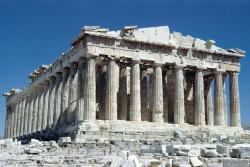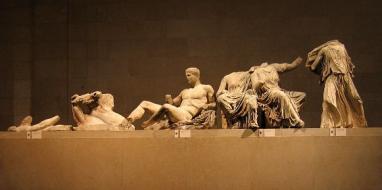The Parthenon Marbles
 On Friday 12th March, the UK Prime Minister Boris Johnson dismissed Greece's call for the return of the Parthenon Marbles to the country, arguing that the 2,500-year-old cultural treasures are legally owned by the British Museum's Trustees. In his first public comments on the issue since becoming the UK Prime Minister, Mr Johnson said in an interview with the Greek daily newspaper Ta Nea, "I understand the strong feelings of the Greek people, and indeed Prime Minister Mitsotakis, on the issue." He continued, "But the UK government has a firm longstanding position on the sculpures, which is that they were legally acquired by Lord Elgin under the appropriate laws of the time and have been legally owned by the British Museum's Trustees since their acquisition."
On Friday 12th March, the UK Prime Minister Boris Johnson dismissed Greece's call for the return of the Parthenon Marbles to the country, arguing that the 2,500-year-old cultural treasures are legally owned by the British Museum's Trustees. In his first public comments on the issue since becoming the UK Prime Minister, Mr Johnson said in an interview with the Greek daily newspaper Ta Nea, "I understand the strong feelings of the Greek people, and indeed Prime Minister Mitsotakis, on the issue." He continued, "But the UK government has a firm longstanding position on the sculpures, which is that they were legally acquired by Lord Elgin under the appropriate laws of the time and have been legally owned by the British Museum's Trustees since their acquisition."
The Greek Culture Minister, Lina Mendoni, challenged the claim made by UK Prime Minister Boris Johnson regarding the so-called 'Elgin Marbles', saying there is evidence to show the Parthenon sculpures were illegally removed from the Acropolis by Britain's Lord Elgin in the early 19th Century. "Upon careful review of the statements made by the UK Prime Minister Mr Boris Johnson, it is clear that he has not been properly informed by the competent state services of his country, or the new historical data regarding Greece's occupation by the Ottomans, that show that there was never a legitimate acquisition of the Parthenon sculputes by Lord Elgin and, therefore, neither the British Museum ever acquiring the sculpures in a legitimate manner. The Greek Ministry of Culture and Sports can provide the necessary documentary evidence that can inform the British people how the British Museum possesses the sculptures illegally, For Greece, the British Museum does not have legitimate ownership or possession of the sculptures."
The Parthenon is among the greatest national treasures of Greece, with important parts of it displayed at the British Museum in London for two centuries. The question that has been asked for many years now is "should these marbles be returned to Athens?"
 The Parthenon Marbles, also known as the Elgin Marbles, were made under the supervision of the architect Phidias and his assistants around 440 BC. They were originally part of the Parthenon temple and other buildings on the Acropolis of Athens. From 1801 to 1812, agents of Thomas Bruce, 7th Earl of Elgin, removed about half of the surviving sculptures of the Parthenon, as well as sculptures from the Propylea and Erechtheum. All the marbles were transported by sea to Britain where the acquisition of the collection was supported by some, while others, such as Lord Byron, compared Elgin's actions to vandalism or looting. Lord Elgin sold the Marbles to the British government in 1816, where they were passed into the trusteeship of the British Museum.
The Parthenon Marbles, also known as the Elgin Marbles, were made under the supervision of the architect Phidias and his assistants around 440 BC. They were originally part of the Parthenon temple and other buildings on the Acropolis of Athens. From 1801 to 1812, agents of Thomas Bruce, 7th Earl of Elgin, removed about half of the surviving sculptures of the Parthenon, as well as sculptures from the Propylea and Erechtheum. All the marbles were transported by sea to Britain where the acquisition of the collection was supported by some, while others, such as Lord Byron, compared Elgin's actions to vandalism or looting. Lord Elgin sold the Marbles to the British government in 1816, where they were passed into the trusteeship of the British Museum.
The Parthenon Marble collection is on display in the British Museum in London, in the purpose-built Duveen Gallery. The new Acropolis Museum in Athens displays a portion of the complete frieze, aligned in orientation and within sight of the Parthenon, with the position of the missing London elements clearly marked and space left should they ever be returned to their place in Athens.